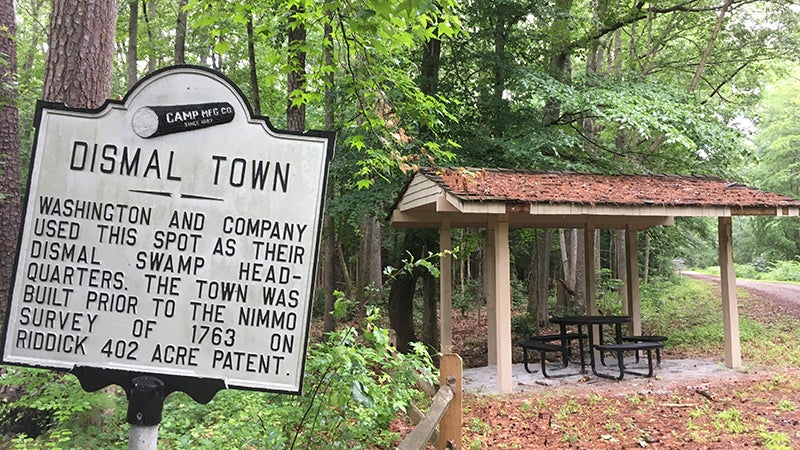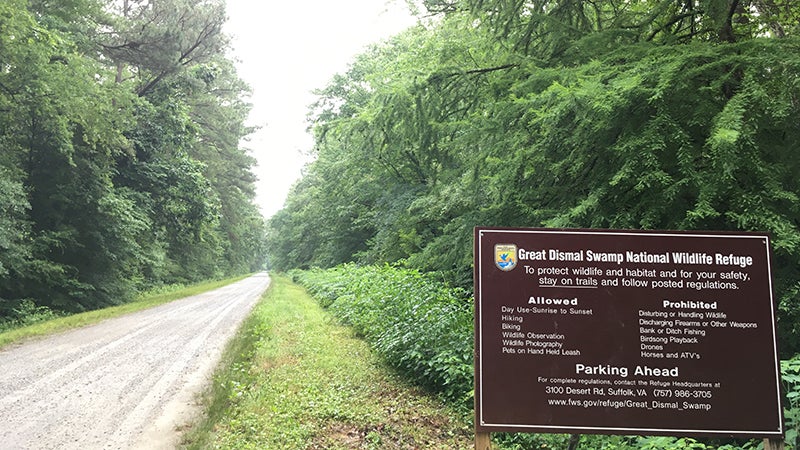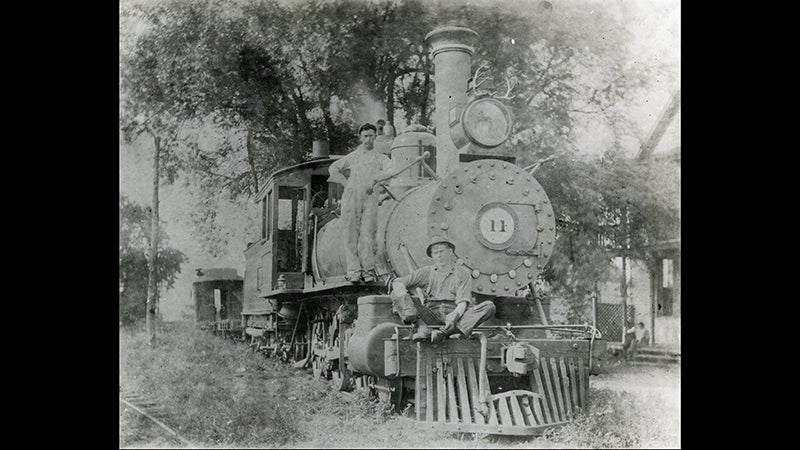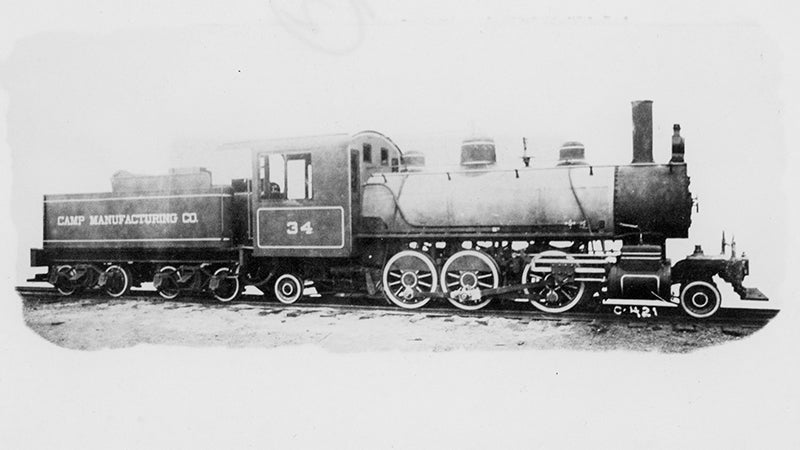Camps in the Swamp
Published 6:36 pm Wednesday, August 26, 2020
|
Getting your Trinity Audio player ready...
|
Company built railroad to transport cut hardwoods, pines
Story and photos by Clyde Parker
During the last half of the 19th century, the family headed by George Camp II of Southampton County and Sallie Cutchins Camp, originally from Isle of Wight County, was at the forefront of logging and lumbering in southeastern Virginia.
Married in 1837, George and Sallie Camp had 10 children: Mary Eliza Camp, John Stafford Camp, Joseph E. Camp, James E. Camp, William Nelson Camp, Paul Douglas Camp, Benjamin Franklin Camp, Sarah Virginia “Jenny” Camp, Robert Judson Camp and James Leonidas Camp. The family resided on the huge Camp Farm located on the northern edge of Franklin Depot bordering the Blackwater River.
In 1887, two of the Camp brothers (James L. and Paul D.) bought from the Neely Brothers a lumber mill that was located on the eastern side of the Blackwater River next to Franklin. That purchase turned out to be the establishment of Camp Manufacturing Co.; soon, brother Robert J. joined the company. And at that time, Camp brothers William Nelson, Benjamin Franklin and John Stafford were participating as shareholders.
Earlier, during the period from the late 1860s well into the 1880s, the Camps had established several other lumber mills along the Nottoway River, at Delaware and Monroe, and near Como in North Carolina; but, later, those mills were closed so that they could concentrate on the Franklin Mill. However, a little later, the Camps changed their minds about adding more mill locations; in 1896, they purchased from John Arringdale a lumber mill at Drewryville and a two-years’ supply of timber — and, in 1902, they bought a large tract of timberland and built a lumber mill at Butterworth in Dinwiddie County.
The Camp brothers had great fascination for the Great Dismal Swamp, even though its western edge was about 20 miles east of Franklin, in Nansemond County, now the city of Suffolk. But it was William Nelson Camp, the fifth child, who knew the swamp best. In his youth, he logged Nansemond County and got to know its secrets. Fourteen years after his 1870 marriage to Texanna Gay of Windsor, he moved his family to Suffolk and started Gay Manufacturing Co., a lumber firm, with his father-in-law, William H. “Pappy” Gay.
During the latter half of the 19th century and well into the early 1900s, when land was cheap, the Camps bought quite a lot of timberland throughout southern Virginia and northeastern North Carolina. Of the tracts they bought, the most significant was 40,000 acres of the Dismal Swamp, which William Nelson Camp negotiated in 1899 from successors to the Dismal Swamp Land Co. (In 1763, George Washington and eight other Virginians obtained free from the colonial Virginia governor a tract of 40,000 unclaimed acres, or about half of the swamp in Virginia. The Dismal Swamp Land Co. was chartered by the Virginia Assembly in 1764.)
William Nelson Camp contracted to pay $76,500, or about $1.92 an acre, for the 40,000-acre tract, then conveying one-fifth of his interest to each of his brothers, Paul, Robert and James, while keeping two-fifths for himself. The Camps were very pleased that they had acquired the same tract of land that was previously owned by George Washington.
Included in the purchased land — a rough rectangle that stretched from near Suffolk in Nansemond County, eastward into Norfolk County, and southward to the North Carolina line — was Lake Drummond, a large but very shallow body of water that was surrounded by many and various kinds of huge, beautiful trees. The trees in those locations along with the many junipers, cedars and cypresses located throughout the entire swamp were what first attracted the Camps. Pine trees became highly desirable later.
During the early 1900s, in order to move timber out of the swamp and into the Franklin lumber mill, William Nelson Camp developed a procedure that involved floating logs into and up the Jericho Canal, which extended from Lake Drummond northward to the headwaters of the Nansemond River in Suffolk. There, the timber was connected with the Portsmouth and Roanoke Railroad (later Seaboard Airline Railroad) which ran through Franklin.
When it was determined, by a court decision, that his plan conflicted and interfered with the canal’s use by a competitive Dismal Swamp business known as Lake Drummond Canal and Water Co., Camp Manufacturing Co. had to find other ways to remove and use their timber. So, they built 59 miles of narrow-gauge railways to facilitate removal and make connections with the railroad at Suffolk.
There was another way to get the timber to the Franklin mill: by narrow-gauge rails to the Dismal Swamp Canal and then down from there by small steam-ships to South Mills in North Carolina where, still by steam-ships, connection was made on the Pasquotank River into the Albemarle Sound. And then, by way of the Chowan and Blackwater rivers, the timber could be shipped to the Camp Mill at Franklin. But, it appears that the least tedious and most economical method for log transport was with the railroad at Suffolk. During the late 1920s and 1930s, a lot of timber shipments were being made by over-the-highway trucks.
During the early years of their swamp ownership, the Camps had other significant, but apparently amicable, competition, notably, Baird and Roper Lumber Co. of Norfolk, which later became known as the John L. Roper Lumber Co., until it was absorbed by Norfolk Southern Corp., and Richmond Cedar Works.
In 1909, William Nelson Camp, then living in Ocala, Fla., transferred his two-fifths interest in his Dismal Swamp purchase to Camp Manufacturing Co., repaying most of the $900,000 in loans he had received from the company. His brother Robert J. Camp’s one-fifth interest was claimed by the company after Robert’s death in 1907. In 1921, brothers Paul D. and James L. Camp Sr. both sold their interests to Camp Manufacturing Co. for $222,300 each. By 1921, all four brothers had conveyed their shares to Camp Manufacturing Co.; the Company then owned the entire 40,000 acres.
In the 1920s, Camp Manufacturing Co. went to court over the Dismal Swamp. This was the second time going to court; this time, it was to resist a claim that their company had laid claim to a small tract owned by others. In order to defend the Camp family’s 1899 purchase, attorneys John Crafford Parker of Franklin and Toy Savage Sr., of Norfolk, searched George Washington’s original hand-written diaries, located in a New York archive, for details of Washington’s Dismal Swamp land-grant.
However, their well-prepared arguments turned out to be unnecessary. During a recess in the Suffolk trial, Paul D. Camp talked with the complainant and suddenly called the lawyers aside. “I’ve talked to the plaintiff,” he said, “and we have settled.” His attorneys packed up and went home.
Over time, the original 40,000-acre William Nelson Camp purchase grew, through additional periodic acquisitions, to more than 49,000 acres.
Dr. Benjamin Franklin Camp and his bride, the former Annie Slade Brett of Como, North Carolina, moved to Campville, Florida, in 1881. He later relocated to White Springs and ventured into lumber, citrus, brickmaking, and phosphate mining.
John Stafford Camp moved from Franklin to Florida in 1888. He operated a company store near the home of brother Benjamin at White Springs.
In 1891, William Nelson Camp and wife Texanna moved to Albion, Florida. He later moved to and helped settle Ocala. He engaged in phosphate mining, cattle, citrus and lumber. In 1907, his holdings included 30,000,000 feet of cypress timber in Florida, about 8,000 acres of cypress timber in North Carolina, and 55,000 acres of pine timber in Florida. In terms of his total personal land ownership in Florida, at 150,000 acres, at that time, he was the largest landholder in Florida.
In addition to all of that, he maintained his interests in several other Camp companies in Florida. And, he stayed connected with his various Virginia endeavors — especially Camp Manufacturing Co. in Franklin. He was constantly back and forth between the two areas.
Jenny Camp Norfleet, upon the death of her husband Nathaniel Norfleet in 1892, moved from Franklin to Newberry, Florida.
Robert J. Camp, for a period of time in the early 1900s, divided his time between Franklin (residence at the foot of Clay Street) and Florida. Primarily, he was secretary-treasurer for Camp Manufacturing Co. in Franklin. He died in 1907.
Paul D. Camp and James L. Camp maintained their residences (“The Elms” and “The Maples” respectively) and their business interests — mostly Camp Manufacturing Co. in Franklin, but also with their partial interests in the Camp businesses in Florida.
Mary Eliza Camp, married to John W. Williams, continued to live in Franklin. In 1892, they moved into their primary residence at 502 Clay St. For a period of time, John Williams was a superintendent at the Franklin lumber mill.
Joseph E. Camp and James E. Camp both died in their youth.
In 1937, paper making operations took place at Franklin through the establishment of Chesapeake-Camp Corp. Camp Manufacturing Co. continued as a separate lumber company.
Getting back to the Dismal Swamp, on May 2, 1944, the “Franklin & Carolina Railroad” was chartered by the Interstate Commerce Commission and was incorporated and wholly owned by Camp Manufacturing Co. Its purpose was to connect the Camp paper mill and sawmill, in Franklin, with the Atlantic Coast Line Railroad in Nansemond County, near Whaleyville, at a place called “Franklin Junction,” and by extension, across the ACL to “Camp 7” on Desert Road. From there, the line continued on to Lake Drummond with branches extending into various other areas of the swamp. Connection with the ACL also facilitated transfer of other materials from that rail line, such as fuel oil, coal and chemicals, necessary to the Franklin Mill operation.
In 1958, the Franklin & Carolina Railroad was sold to the Atlantic Coast Line Railroad which continued to serve the Franklin Mill. In 1967, the Seaboard Airline Railroad merged with the Atlantic Coast Line to form the Seaboard Coast Line Railroad, which already had connection to the Franklin mill site. In 1972, most of the old Franklin & Carolina tracks were removed.
Camp Manufacturing Co. cut many hardwoods and pines from the swamp into the 1950s. In 1973, Union Camp Corporation, successor to Camp Manufacturing Co., deeded their Dismal Swamp ownership to the Nature Conservancy. It is now a part of what is known as the Great Dismal Swamp National Wildlife Refuge.
Incidentally, during the 1880s, William Nelson Camp was involved in a project entirely different from his other ventures: the establishment of a hydro-electric plant in Roanoke. He went there and got consent to build a dam on the Roanoke River, and harness the power generated by the water rolling over the dam. In 1888, he organized the Roanoke Water Power Co. and was its president. Some years later, in 1908, he put forth plans to light the streets and public places in the City of Roanoke. About 250 arc lights were put throughout the city. Robert Clifton Camp, William Nelson Camp’s second son, had moved from his Suffolk home to Roanoke to become general manager of the company. He later sold the company at a good profit.
Sources:
Elms Foundation; Clifford A. Hedgepeth Jr.; Southampton County Historical Society; and “Timber Tycoons” by Parke S. Rouse Jr.










